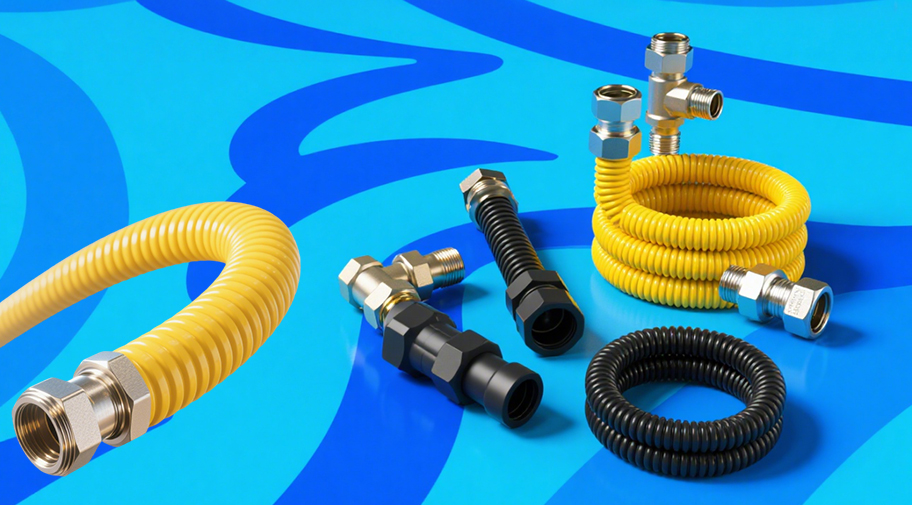-
+86-574-62166708
-
-









Air conditioning and ventilation systems (including central air conditioning, commercial ventilation, clean air conditioning, etc.) have core requirements for pipelines, such as smooth air/medium transmission, vibration resistance and noise reduction, temperature and moisture resistance, flexible installation, and long-term stability. Traditional air ducts (such as galvanized steel sheet ducts) have problems such as high rigidity and large vibration noise, while plastic pipes are limited by temperature resistance and strength. Stainless steel bellows, with their unique material and structural advantages, can effectively adapt to the complex working conditions of air conditioning and ventilation systems, becoming an ideal choice to optimize pipeline performance. The following elaborates on specific application solutions from multiple dimensions.
Precise Matching of Core Performance Advantages with System Requirements
The operating environment of air conditioning and ventilation systems is characterized by temperature fluctuations (-10℃ to 80℃), high air humidity, frequent equipment vibration, and the need to reduce wind resistance and noise. The performance of stainless steel bellows can accurately meet these requirements:
Excellent Temperature and Moisture Resistance: 304 stainless steel can work stably in the temperature range of -40℃ to 300℃, fully covering the requirements of air conditioning systems for supply air (12-18℃), return air (room temperature) and ventilation systems for exhaust temperature (-10℃ to 60℃); at the same time, stainless steel does not absorb water or mildew, and can resist corrosion in high-humidity environments (such as basements, swimming pool ventilation), avoiding pipeline rust or bacterial growth.
Vibration Resistance and Noise Reduction Capability: The annular corrugated structure of the bellows has good elastic shock absorption performance, which can absorb vibrations generated by the operation of air conditioning units and fans (vibration frequency 10-100Hz), reduce the transmission of vibrations to pipelines and building structures, and reduce noise (compared with rigid air ducts, it can reduce noise by 5-15dB); it is especially suitable for places sensitive to noise such as hospitals and laboratories.
Low Wind Resistance and Airflow Stability: The inner wall of the bellows, after smooth treatment (Ra≤1.6μm), has a wind resistance coefficient (λ) as low as 0.02-0.03, which is much lower than the local resistance of traditional rectangular air ducts; the annular cross-sectional design makes the airflow distribution more uniform, avoids eddy currents, and improves the heat exchange efficiency of air conditioning systems and the ventilation effect of ventilation systems.
Installation Flexibility and Space Adaptability: Bellows can be bent arbitrarily (minimum bending radius is 3-5 times the pipe diameter), and can easily bypass obstacles such as beams, columns, and pipes, reducing the use of elbows, tees and other accessories; for narrow spaces (such as ceiling mezzanines, equipment rooms), their flexible characteristics can simplify the installation process and reduce construction difficulty.
Strength and Service Life Advantages: The tensile strength of stainless steel (≥520MPa) is much higher than that of plastic pipes, with impact resistance, which can withstand positive pressure (≤2000Pa) and negative pressure (≥-500Pa) in the air duct, meeting the requirements of high-pressure air supply systems; the service life can reach more than 20 years, far exceeding the anti-corrosion cycle of galvanized steel sheet air ducts (8-12 years).
Typical Application Scenarios
Stainless steel bellows can specifically solve the application pain points of traditional pipelines in different links of air conditioning and ventilation systems:
Central Air Conditioning Systems
Connection section between air conditioning units and air ducts: At the air outlet of water chillers and air handling units, bellows can absorb the vibration from equipment operation, avoid air duct resonance noise caused by rigid connections; at the same time, compensate for displacement between units and air ducts due to installation errors or temperature changes.
Connection between fan coils and branch pipes: Small-caliber (DN80-DN200) bellows are suitable for supply/return air ducts of fan coils. The flexible structure reduces the transmission of fan vibration, and the smooth inner wall does not accumulate dust, reducing the frequency of cleaning and maintenance of air conditioning systems.
Refrigerant pipeline connection: In the refrigerant (such as R32, R410A) pipelines of multi-split air conditioners, bellows can adapt to temperature changes (-15℃ to 60℃) during refrigerant circulation, and their vibration resistance prevents refrigerant leakage caused by loose interfaces.
Commercial and Industrial Ventilation Systems
Kitchen exhaust pipes: Stainless steel bellows are resistant to oil fume corrosion, and their bendable characteristics adapt to the complex spatial layout of kitchens. Their high-temperature resistance (≤300℃) can cope with the instantaneous high temperature of oil fume, which is safer than plastic pipes.
Industrial workshop ventilation: In dusty and humid workshops (such as food processing, machinery manufacturing), the corrosion resistance of bellows can resist dust erosion and condensation water rust. The flexible design facilitates the connection of ventilation outlets in different areas, improving ventilation efficiency.
Fire smoke exhaust systems: High-temperature stainless steel bellows (such as 316 material) can work continuously at 280℃ for more than 30 minutes, meeting the fire resistance requirements of fire smoke exhaust, and their vibration resistance ensures that the pipes do not fall off in case of fire.
Clean Air Conditioning and Special Ventilation
Ventilation in hospital clean operating rooms: Bellows with electrolytically polished inner walls (Ra≤0.8μm) do not accumulate dust and are easy to disinfect, meeting GMP clean standards, reducing the risk of bacterial growth, and adapting to the high-efficiency filtration ventilation system in operating rooms.
Exhaust from laboratory fume hoods: Bellows can connect fume hoods to main air ducts. The chemical corrosion resistance (316 material) resists erosion from laboratory exhaust gas (such as acid-base gases), and the flexible structure facilitates adjusting the installation position of fume hoods.
Air conditioning and ventilation in data centers: In high-density server rooms, bellows can accurately connect air conditioning outlets and cabinet air ducts, reduce cold air loss, and their vibration resistance reduces the interference of air conditioning fans on server operation.
III. Key Selection Points and Installation Specifications
1. Scientific Selection
Material and Caliber: 304 stainless steel is selected for ordinary air conditioning and ventilation systems; 316 stainless steel is selected for humid and corrosive environments (such as kitchens, laboratories); calibers are selected according to air volume requirements from DN50-DN600 (DN100-DN300 is commonly used for civil purposes, DN300-DN600 for industrial purposes).
Pressure and Temperature Rating: Select the corresponding pressure rating according to the system air pressure (1000Pa rating is selected for conventional air duct systems, 2000Pa rating for high-pressure air supply systems); special bellows with temperature resistance ≥280℃ are required for high-temperature scenarios (such as fire smoke exhaust).
Connection Method: Flange connection is used for connecting with equipment interfaces (equipped with rubber gaskets to enhance sealing and shock absorption); clamp connection can be used for air duct section connection (easy to disassemble and clean); welded connection is recommended for clean systems (to reduce leakage points).
Length and Compensation Amount: Determine the length according to installation distance and vibration displacement requirements, and reserve 5%-10% expansion margin to ensure that the bellows can expand and contract freely during vibration or temperature changes, avoiding excessive stretching.
2. Installation Specifications
Cleaning and Pretreatment: Before installation, remove oil stains and impurities in the bellows. Clean systems need to be cleaned with pure water and dried; for ventilation systems related to food and medicine, oil-free treated bellows must be selected to avoid air pollution.
Bending and Fixing: When bending, control the bending radius ≥ the value specified by the product (such as the bending radius of DN200 bellows ≥600mm), and prohibit sharp bends or twists; set sliding supports every 3-5 meters in the straight section (allowing axial movement), and add shock-absorbing supports near vibration sources to reduce pipeline shaking.
Sealing and Noise Reduction Measures: When flange connection is used, tighten the bolts evenly to ensure that the gasket is fully fitted; between vibrating equipment such as fans and air conditioning units and bellows, rubber shock absorbers can be added to further enhance the noise reduction effect.
Testing and Acceptance: After installation, conduct an air pressure test (the test pressure of positive pressure systems is 1.2 times the design pressure, and the pressure is maintained for 1 hour without leakage); during operation, detect the noise value (which should meet the noise standards of the place, such as hospitals ≤40dB).
Application Benefits
Improve System Comfort: Vibration resistance and noise reduction characteristics make air conditioning and ventilation systems run quieter, especially in residences, hotels and other places, which can significantly improve living experience; low wind resistance design reduces airflow noise, avoiding the "wind howl" of traditional air ducts.
Reduce Maintenance Costs: Stainless steel is corrosion-resistant and moisture-resistant, reducing the frequency of replacement due to pipeline rust and mildew, and annual maintenance costs can be reduced by 30%-50%; the smooth inner wall is not easy to accumulate dust, and the cleaning cycle is extended to 1-2 years (traditional air ducts are 3-6 months).
Enhance System Safety: In fire smoke exhaust systems, high-temperature resistant bellows can ensure the smoothness of smoke exhaust channels in case of fire; impact resistance prevents air ducts from being damaged due to vibration and collision, reducing the risk of air leakage.
Improve Installation Efficiency: The flexible structure reduces the use of accessories and on-site cutting and processing, shortening the installation period by 20%-40%, which is especially suitable for the transformation of air conditioning and ventilation systems in old buildings, reducing damage to the original structure.
Summary
Through the optimization of material and structure, stainless steel bellows achieve comprehensive performance of "low noise and high efficiency, corrosion resistance and durability, and flexible adaptation" in air conditioning and ventilation systems. Whether it is comfortable air conditioning in civil buildings or special ventilation in industrial places, they can provide reliable pipeline solutions, laying a solid foundation for the stable operation and performance improvement of the system.